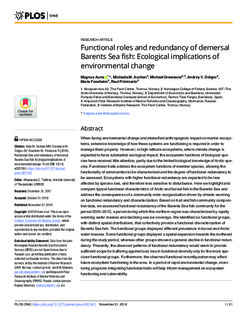| dc.description.abstract | When facing environmental change and intensified anthropogenic impact on marine ecosystems, extensive knowledge of how these systems are functioning is required in order to manage them properly. However, in high-latitude ecosystems, where climate change is expected to have substantial ecological impact, the ecosystem functions of biological species have received little attention, partly due to the limited biological knowledge of Arctic species. Functional traits address the ecosystem functions of member species, allowing the functionality of communities to be characterised and the degree of functional redundancy to be assessed. Ecosystems with higher functional redundancy are expected to be less affected by species loss, and therefore less sensitive to disturbance. Here we highlight and compare typical functional characteristics of Arctic and boreal fish in the Barents Sea and address the consequences of a community-wide reorganization driven by climate warming on functional redundancy and characterization. Based on trait and fish community composition data, we assessed functional redundancy of the Barents Sea fish community for the period 2004–2012, a period during which this northern region was characterized by rapidly warming water masses and declining sea ice coverage. We identified six functional groups, with distinct spatial distributions, that collectively provide a functional characterization of Barents Sea fish. The functional groups displayed different prevalence in boreal and Arctic water masses. Some functional groups displayed a spatial expansion towards the northeast during the study period, whereas other groups showed a general decline in functional redundancy. Presently, the observed patterns of functional redundancy would seem to provide sufficient scope for buffering against local loss in functional diversity only for the more speciose functional groups. Furthermore, the observed functional reconfiguration may affect future ecosystem functioning in the area. In a period of rapid environmental change, monitoring programs integrating functional traits will help inform management on ecosystem functioning and vulnerability. | nb_NO |
